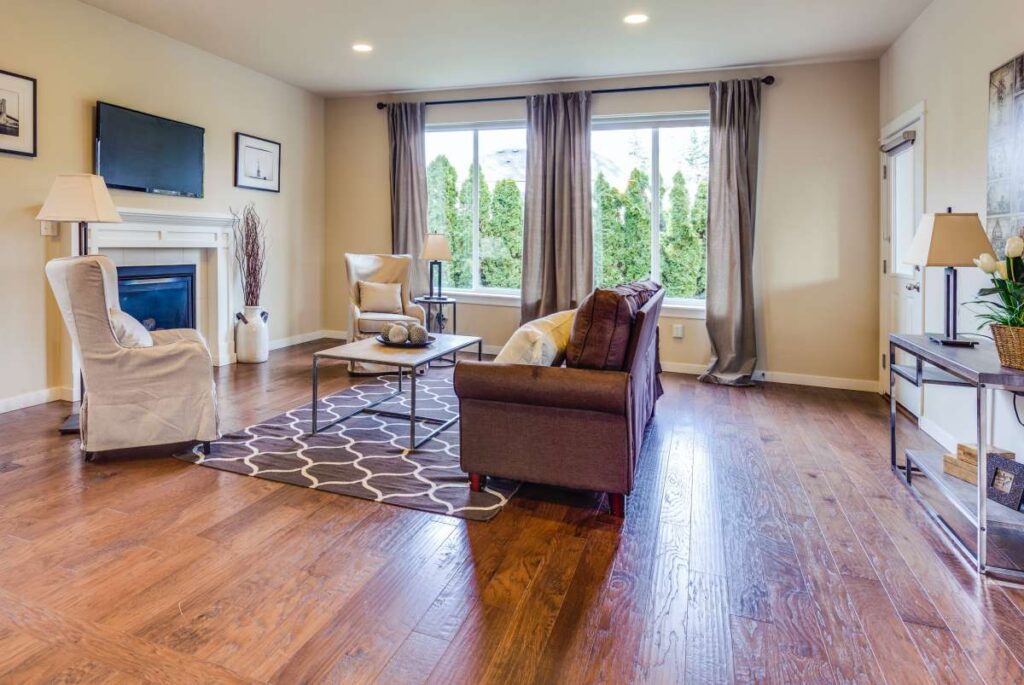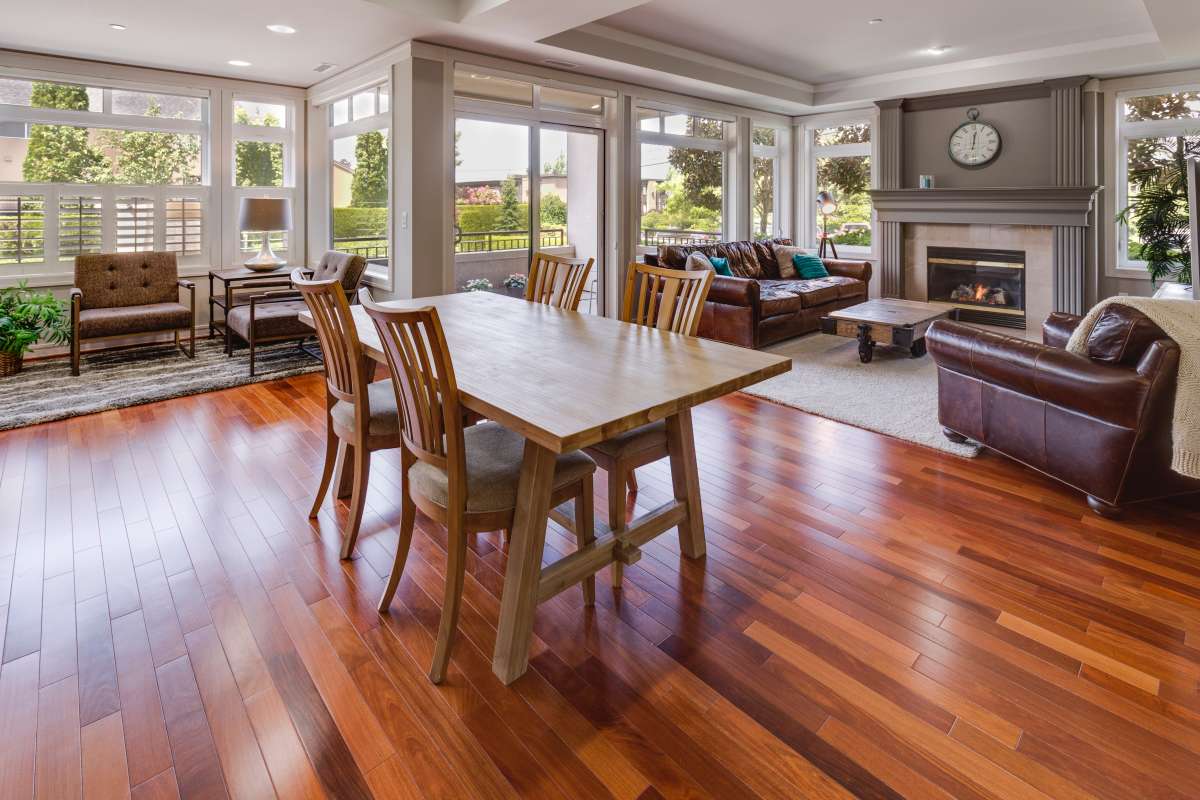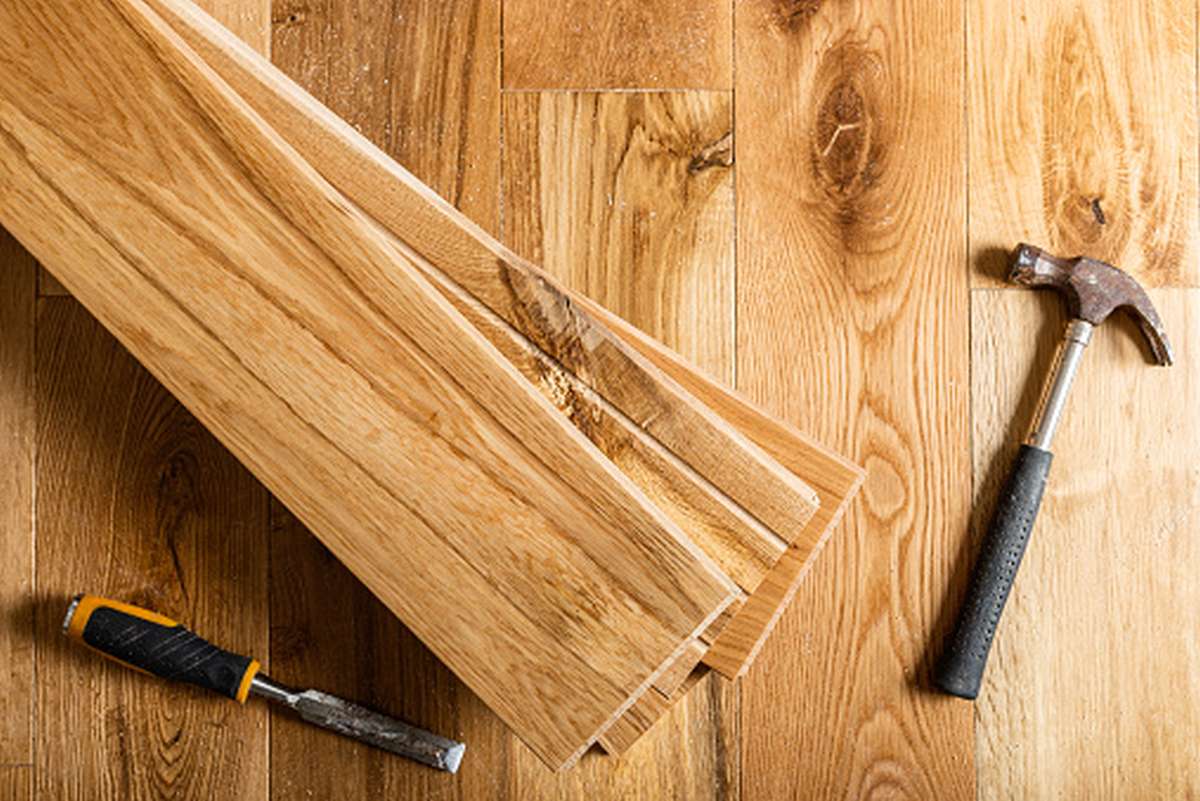Hardwood floor sanding is a huge, filthy, and expensive project that should be avoided. Unfortunately, it's possible that sanding your floor is not the best option, even though you've got the time and money to do it. For example, it could have been sanded too much, or the veneer could be very thin. Fortunately, you don't have to choose between leaving the floor as-is and installing a new one.
Screen and recoat is the greatest method for refinishing wood floors without sanding. Instead, a floor buffer is used to rough up the finish, and a new coat is applied. Professionals may call this process "sandless refinishing," but the term can also refer to one in which a chemical etcher is used instead of a buffer. The former is a tried and true approach to floor repair, but the latter is the equivalent of a Hail Mary in the world of floor maintenance. It might or might not be effective.
Sandless refinishing, especially the chemical approach, is what you need if your laminate floor is old and worn out. It's your only choice short of ripping up the floor and starting over. Yet, there are times when sandless is not the best option for wooden floors. However, it is ineffective at repairing cupping or crowning and will not remove deep scratches or stains. This process can be used to make the floor darker, but sanding is required to make it lighter.
You can typically tell if your floor is over-sanded or features a thin veneer by removing a door threshold and inspecting the wood in cross-section. You can also use your finger to feel for gaps between floorboards. It's not a good idea to sand the floor if you can feel the wood giving or notice that the covering is very thin in a cross-section of a board.
To remove the old finish, a floor buffer fitted with a sander screen is used, hence the name "screen and recoat." When the floor has dried from being mopped, you can buff it using a sanding screen that is 120 grit. If you do not want to remove the finish and the scratches, use a screen no coarser than that.
Once the floor has been screened, vacuum up the debris, tack the floor down, and apply two coats of clear floor finish. If the stain is development puts after the vetting process and subsequently sealed with only a clear finish, darker stains can be put on hardwood floors without sanding. Using a waterborne finish that dries in a day will allow you to accomplish the job in a single day. There will be some dust created, but not nearly as much as if you were sanding the floor.
Hardwood floor refinishing kits typically include everything you need to complete the chemical etch process. In addition, it comes with the necessary equipment for using the chemical etcher and the clear finish.
A spotless floor is required before using the etcher. Then, it can be applied using the included tools or with a paint pad. To ensure proper adhesion of the new finish, this product acts similarly to acid by removing the shine from the old one.
Once the etching compound has dried, apply the clear coat using a paint pad or the included application tool. Staining is an optional step in this restoration process. This process occurs between applying the wiping compound and the final coating.
Your rental's hardwood floors have seen better days. However, after a few months of tenants, your when first floors are likely to be far from spotless and could want a touch-up due to furniture turnover (moving), regular use, and the addition of animals (if you allow them).
Most homeowners believe that to restore a property's "like-new" appearance. The flooring must be sanded down, refinished, and resealed. Hardwood floors can be refreshed in a single day, sparing you the mess, labour, and price of sanding off the current finish if the damage is superficial (normal wearing, scrapes in the finish, and only a few deeper cuts that pierce that wood itself). Looking for home renovations in Melbourne? Look no further! Hitch Property Constructions has you covered.
Methods for Refinishing Wood Flooring Without Sanding
- Get an abrasive chemical kit and use that.
- Floors need scrubbing and a new coat of polyurethane.
- Try an energiser
If you want to spruce up your flooring on your own, it's ideal to do it in the downtime between tenants, so you don't have to shuffle furniture around or make anyone leave for 48 hours. By reading on, find out if this is the most effective method for revitalising or restoring your floors.
Use a Chemical Abrasion Kit Available
Your neighbourhood hardware and home improvement store should carry this do-it-yourself kit (or online). Other brands may use slightly different product names, but the manufacturing method is universal. To get the new finish to adhere to the floor, you must first etch the old finish with a chemical solution. Then, the floor must be restored by applying a fresh finish.
It's recommended that you follow the kit's instructions for optimum results, but if you're curious about how this particular kit stacks up against the competition, keep reading!
Pros and Cons of Materials
Materials:
- Tools for cleaning hardwood floors, such as spray, mop, broom, vacuum, wipes, moist cloth, etc.
- Masking tape
- Abrasive chemicals
- Two disposable trash liners
- Double shoeboxes
- You'll need two paint trays if you don't have any waste bags or shoe boxes.
- Clorox wipes
- Sweepstakes grip
- Garbage disposal fluid
- Toe caps
- Paint on wood
- A cotton swab or small paintbrush for the artist.
- Hairdryer Paintbrushes or paint pads Rags
Pros:
- All the essentials can be found in one convenient package.
- It produces no dust and barely any odours.
Cons:
- needing more than one person to complete successfully
- You need to hurry up and get the finish on before it dries.
Tidy Up and Put Things Away
Get rid of anything that could potentially be on the floor. Hopefully, that's the case if the tenant has left. If the floor installation requires moving any furniture or fixtures, please remove them. It is still necessary to follow the correct protocol when removing a former tenant's possessions from a rental unit.
In addition, remove the doors from their frames. Even if you try to get around them, doors like closets and entryways will always be in the way, making it difficult to clean the floor thoroughly.
In addition, use a vacuum and a damp mop to clean the floor instead of chemical cleansers. Get rid of any dirt or dust that may have accumulated on any room's surfaces. If dust or other particles drop on the wet floor finish, they will dry into flaws. We are using an abrasive sponge to remove any filth from the floor. After mopping, let the floor air dry.
To prepare the area, stuff old towels into air vents or ducts. Put up those shutters and switch off the exhaust fans! To prevent dust from spreading further, ventilation must be shut off. Protect your baseboards from paint drips with painter's tape. In addition, make sure the curtains or blinds are drawn so that the floor doesn't get too much direct sunlight since this could cause the finishes to dry too quickly in certain areas.
Clean the floor with the liquid abrasive and apply it.
Scrub the liquid toward the wood grain using the abrasive pad included with the kit. When the pad is in place, the broom handle can always be fastened to the block. If you cannot find a broom handle, you may do this on your knees; make sure to wear clothes you don't mind going dirty.
Instead of using a painter's tray, you can pour the pad's chemical irritant into a PVC shoe box to catch drips and keep the chemical from spilling. Press the pad down, then, to get the excess coating off the pad and the box.
Roughen the floor by concentrating on 4-foot-by-4-foot portions and pressing down firmly on them. You won't get the best results by sweeping the floor and scrubbing one area many times. If the solution is left mostly on the the floor for more than 5 minutes, it will soak into the cracks between the parquet strips and destroy the core beneath the laminate.
Before moving on, wipe down the area with an old towel to remove any liquid that may have accumulated. A thin film of liquid is preferable to a perfectly dry floor.
You can open a window or turn on a fan in another room to get some fresh air while working with this chemical etching liquid. There shouldn't be much delay here.
Wait 30 minutes after engraving the entire floor. Then, please take the sanding pad off the slab until further notice. The pad can be discarded, but the block should be kept clean for the finishing steps.
Repeat Floor Cleaning
Dish soap dissolution: 2 tablespoons per gallon of hot water, stirred. The corrosive etcher residue on the floor can be cleaned up with a wet mop.
We use a dry mop instead of a wet one to protect the floor from water damage. Mop in stages and clean up spills as they occur.
Using shoe covers will prevent dirt and debris from being tracked onto the floor. However, it will take at least another half an hour for the floor to dry.
Repair More Serious Scrapes
Apply some matching stain with a small artist's paintbrush or a cotton swab. Spread the stain with a feathered edge and dab it until it disappears into the floor.
Apply a thin coat of the kit's finishing coat after letting the stain dry for a minute under a hair dryer. The edge finishing should be feathered out with no visible or perceptible ridges. Then, repeat the process of using the hair dryer to dry the area.
Apply a Fresh Coating to the Floor
First, round up two helpers and formulate a strategy for applying the coating. You shouldn't feel cornered or lacking the resources to complete the task. Cover your feet with anything, people.
After transferring the liquid, finish the block by laying the pad on top. This helps coat the applicator evenly without leaking too much. Yet, bubbles may form if the surplus is squeezed out.
Give your assistant a head start on painting the edges against cabinets and baseboards with such paint pads or brush while you spread the finish on the floor.
To make the tools, you'll be using to apply the finish more flexible, lightly wet them. It would be best to give them a quick rinse in water and then compress them until they are barely damp.
Working with the texture of the carpet and gently pulling the applicator at an angle will help the excess finish spread to the moist side of the ground and provide a smooth application. If you notice any drips or puddles, have your second assistant follow you immediately behind you while using a brush to clean them up.
Any excess varnish should be wiped up before it dries. If you want a professional look, apply the finishing touch with as few strokes as possible—one steady draw should do the trick. You don't want that horrible dry-brush effect, so make sure the pad always stays wet. The finish's milky, streaky appearance shouldn't be a concern either; as it dries, it will be transparent.
You may have as little as five minutes to smooth out the finish before it becomes sticky and hard to do so, depending on the kit's finish. After the finish gets sticky, you should leave any flaws alone; trying to rectify them at this time would make matters worse.
This is why preparing your application strategy and having your tools ready is crucial. First, let it dry, and then carefully remove it with a razor if you see a leak that will cause a lump.
Most finishes can be restored with just one coat of paint. However, a second coat is recommended to protect the underneath wood and cover the deeper scratches.
Ensure you have enough paint or varnish to give the room a second coat before you start. Remember to keep the can at least halfway full. If you're running low, you should head to the hardware store; putting on a second coat requires waiting at least three hours.
Let the Coating Dry
For optimal results, read and implement the labelled instructions. After eight hours, though, you should be able to stroll barefoot on the floor. After a day, it is safe to move furniture. For best results, wait two weeks after finishing before installing an area rug.
This is why you should wait at least two weeks before letting tenants into the property. You don't want them to lay a rug over what you just finished. So instead, check out our range of timber repairs in Melbourne at Hitch Property Constructions.
Polyurethane Polishing and Recoating
The method is analogous to chemical abrasion. However, a buffer is used to rough up the floors rather than a liquid. It may look like you're sanding when you buff, but you're roughing up the existing surface so the new finish will bind. You're not doing a thorough sanding to remove the finish and scratches; instead, you're just getting it roughed up with the screening. This is only a temporary fix for blemishes on the surface.
Pros and Cons Materials
Materials:
- Equipment for cleaning hardwood floors, such as spray, mop, broom, vacuum, wipes, scouring pads, etc.
- Paid for a buffer
- Liquid minerals
- Paint on wood
- A cotton swab or small paintbrush for the artist.
- Screen sanding
- Hammer
- Putty\Nails
- Axial fan
- Wrapping in plastic
- Masking tape
- Tape for painters
- Protection from dust
- Polyurethane
- Brush or roller for painting
- Garbage receptacle liner
- Shoebox
- If you don't have a garbage bag or shoebox, use this as a paint tray.
- Pad for applying adhesives
- Blocking applicator
- Sweepstakes grip
Pros:
- The best method for preparing a floor for refinishing
- The highest-quality Do-It-Yourself method
- Long-lasting
Cons:
- Needs the use of rented equipment
- More dust is created, necessitating a more extensive cleanup effort.
- Needs extra work put in by hand
Using a Rejuvenating Polyurethane Gloss that is Water-Based
Start picking up a shampoo from your neighbourhood home improvement store if your floors have minimal wear and you're just looking to freshen them. One viable alternative is Rejuvenate Floor Restorer and Protectant. Wood floors can be brought back to life with the help of a floor revitalises, which does double duty as a protective finish and a filler for scratches. Using a revitaliser is just the way to go if you have a modest budget, little time, and only want to brighten up a house for potential or incoming renters.
Materials and Pros and Cons
Materials:
- Equipment for cleaning hardwood floors, such as spray, mop, broom, vacuum, wipes, scouring pads, etc.
- Rejuvenating fluid
- Tape for painters
- The revitaliser can be used with a mop or a paint roller.
- Garbage receptacle liner
- You can use a shoebox as a paint tray if you don't have a trash bag or shoebox.
Pros:
- The most efficient, convenient, and inexpensive method
- Fewest required resources
- It's doable by a single individual.
Cons:
- More worn flooring reduces its effectiveness.
- More frequent applications are required for optimum effects.
Expert Opinion Should Always Come First
Consult professionals in floor refinishing before attempting any do-it-yourself home improvement job. It could be the clerk at the home improvement store, a professional, a neighbour, or a friend. You are the most knowledgeable about your flooring options, so select the finest choice for your home. Make careful to time it properly between renters. Hitch Property Constructions offers carpentry services in Melbourne for residential and commercial projects.
FAQs About Hardwood Floors
Applying a Revitalizer. Applying a revitaliser gloss is the simplest and cheapest way to refinish hardwood floors. This approach works best on floors that only have surface-level scratches and other minor wear and tear issues. You can get the job done without needing equipment rentals or hard-to-find materials.
To condition and shine when done cleaning, add some vegetable or olive oil to a little undiluted white vinegar and rub it into the floor— like adding a finishing product for shine after you shampoo!
Combine 2 cups warm water and 1/4 cup distilled white vinegar. Dip a soft-bristled toothbrush in the solution and shake until just damp. Gently scrub the cracks and then wipe away the debris with a soft cloth or vacuum it up with a handheld vac or a vacuum with a crevice tool. Dust, mop, and clean the floor as usual.
Since vinegar is an acid, it will actually break down the finish on the surface of your floor, and over time it will reduce the shine and leave a dull appearance. Using vinegar and water to clean floors can also lead to excessive water on the floor, which can cause swelling and discolouration.
Daily: Dry mop floors with a microfiber dusting pad and mop. Clean spills immediately. Weekly: Clean deeper with a vacuum designed for wood floors or use a microfiber spray mop and cleaner formulated for hardwood floors. Monthly: Polish wood floors every 2-4 months for extra shine and protection.



